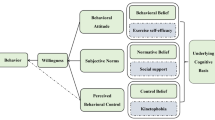Abstract
Exercise plays an important preventive and rehabilitative role in coronary heart disease. Unfortunately, cardiac rehabilitation exercise programs have high drop out rates. Several studies with noncardiac patients indicate that exercise-related strategies engaged in during exercise play an important role in exercise performance and adherence. We assessed exercise-related cognitions utilized by a group of cardiac rehabilitation patients who were adherent to a structured exercise program. Thirty-six subjects provided information on their cardiac history and exercise patterns and reported on the thoughts that they might have when exercising in situations depicted in 11 vignettes. Responses, rated using a reliable coding scheme, revealed that the majority of thoughts involved evaluating progress relative to goals and engaging in motivational self-talk. Other strategies reported included using cognitive distraction, thinking about body shape and arousal, making comparisons between self and others, and engaging in social distraction and interaction. Findings suggest that the exercise adherent subjects in this study use specific cognitive and behavioral strategies. Future studies comparing exercise thoughts of both adherent and nonadherent persons and prospective evaluation of their relationships to exercise adherence appear warranted.
Similar content being viewed by others
References
Andrew, G. M., Oldridge, N. B., Parker, T. O., Cunningham, D. A., Rechnitzer, P. A., Jones, N. L., Buck, C., Kavanagh, T., Shepard, R. J., and Sutton, J. R. (1981). Reasons for dropout from exercise programs in post-coronary patients.Medicare Sci. Sports Exer. 13: 164–168.
Atkins, C., Kaplan, R., Timms, R., Reinsch, S., and Lofback, K. (1984). Behavioral exercise programs in the management of chronic obstructive pulmonary disease.J. Consult. Clin. Psychol. 51: 591–603.
Burton, D. (1989). Winning isn't everything: Examining the impact of performance goals on collegiate swimmer's congnitions and performance.Sport Psychol. 3: 105–132.
Dishman, R. K. (1991). Increasing and maintaining exercise and physical activity.Behav. Ther. 22: 356–378.
Dubbert, P., and Stetson, B. (1995). Exercise and physical activity. In Goreczny, A. J. (ed).Handbook of Health and Rehabilitation Psychology, Plenum Press, New York (in press).
Dubbert, P., Rappaport, N., and Martin, J. (1987). Exercise in cardiovascular disease.Behav. Modif. 11: 329–347.
Ebbeck, V. (1990). Sources of performance information in the exercise setting.J. Sport Exer. Psychol. 12: 56–65.
House, J. S., Robbins, C., and Metzner, H. L. (1982). The association of social relationships and activities with mortality: Prospective evidence from the Tecumseh Community Health Study.Am. J. Epidemiol. 116: 123–140.
King, A. C., Bild, D., Dishman, R. K., Dubbert, P. M., Marcus, B. M., Oldridge, N., Paffenbarger, R. S., Jr., Powell, K. E., Yaeger, K., and Blair, S. N. (1992). Determinants of physical activity and intervention in adults.Med. Sci. Sports Exer. 24: S221-S236.
Marlatt, G. A., and Gordon, J. R. (1985).Relapse Prevention, Guilford Press, New York.
Martin, J., Dubbert, P., Katell, A., Thompson, J., Raczynski, J., Lake, M., Smith, P., Webster, J., Sikora, T., and Cohen, R. (1984). Behavioral control of exercise in sedentary adults: Studies 1 through 6.J. Consult. Clin. Psychol. 52: 795–811.
Meyers, A. W., and Schleser, R. (1980). A cognitive behavioral intervention for improving basketball performance.J. Sport Psychol. 2: 69–73.
Morgan, W. P., and Pollack, M. (1977). Psychologic characterization of the elite distance runner. In Milvy, P. (ed.),The Marathon: Physiological, Medical, Epidemiological and Psychological Studies. Ann. N.Y. Acad. Sci., pp. 382–403.
Okwumabua, T. M., Meyers, A. W., Schleser, R., and Cooke, C. J. (1983). Cognitive strategies and running performance: An exploratory study.Cognit. Ther. Res. 7: 363–370.
Oldridge, N. B. (1982). Compliance and exercise in primary and secondary prevention of coronary heart disease: A review.Prev. Med. 11: 56–70.
Oldridge, N. B., and Jones, N. L. (1986). Preventive use of exercise rehabilitation after myocardial infarction.Acta Med. Scand. Suppl. 711: 123–129.
Oldridge, N. B., Donner, A. P., Buck, C. W., Jones, N. L., Andrew, G. M., Parker, J. O., Cunningham, D. A., Kavanagh, T., Rechnitzer, P. A., and Sutton, J. R. (1983). Predictors of dropout from cardiac rehabilitation: Ontario Exercise-Heart Collaborative Study.Am. J. Cardiol. 51: 70–74.
Prochaska, J. O., DiClemente, C. C., and Norcross, J. C. (1992). In search of how people change.Am. Psychol. 47: 1102–1114.
Shelton, T. O., and Mahoney, M. J. (1978). The content and effect of “psyching up” strategies in weight lifters.Cognit. Ther. Res. 2: 275–284.
Author information
Authors and Affiliations
Rights and permissions
About this article
Cite this article
Stetson, B.A., Frommelt, S.J., Boutelle, K.N. et al. Exercise-related thoughts in cardiac exercise programs: A study of exercise-adherent cardiac rehabilitation patients. Int J Rehab Health 1, 125–136 (1995). https://doi.org/10.1007/BF02213891
Issue Date:
DOI: https://doi.org/10.1007/BF02213891




